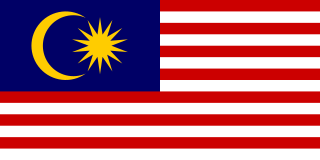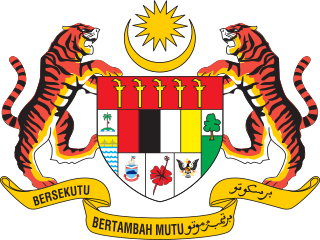This is a list of years in the Peninsular Malaysia until 1963 and Malaysia since 1963. See also Timeline of Malaysian history.
This is a list of years in the Peninsular Malaysia until 1963 and Malaysia since 1963. See also Timeline of Malaysian history.

East Malaysia, or the Borneo States, also known as Malaysian Borneo, is the part of Malaysia on and near the island of Borneo, the world's third-largest island. East Malaysia comprises the states of Sabah, Sarawak, and the Federal Territory of Labuan. The small independent nation of Brunei comprises two enclaves in Sarawak. To the south and southeast is the Indonesian portion of Borneo, Kalimantan. East Malaysia lies to the east of Peninsular Malaysia, the part of the country on the Malay Peninsula. The two are separated by the South China Sea.

The Indonesia–Malaysia confrontation or Borneo confrontation was an armed conflict from 1963 to 1966 that stemmed from Indonesia's opposition to the creation of the state of Malaysia from the Federation of Malaya. After Indonesian president Sukarno was deposed in 1966, the dispute ended peacefully.

The Federation of Malaya was a federation of what previously had been British Malaya, comprising eleven states that existed from 1 February 1948 until 16 September 1963. The Federation became independent on 31 August 1957, and in 1963, Malaysia was formed when Malaya united with Singapore, North Borneo, and Sarawak.

The national flag of Malaysia, also known as the Stripes of Glory, is composed of a field of 14 alternating red and white stripes along the fly and a blue canton bearing a crescent and a 14-point star known as the Bintang Persekutuan. The 14 stripes, of equal width, represent the equal status in the federation of the 13 member states and the federal territories, while the 14 points of the star represent the unity among these entities. The crescent represents Islam, the country's state religion; the blue canton symbolises the unity of the Malaysian people; the yellow of the star and crescent is the royal colour of the Malay rulers. It is in the stars and stripes and the flag families.
The states and federal territories of Malaysia are the principal administrative divisions of Malaysia. Malaysia is a federation of 13 states (Negeri) and 3 federal territories.

The coat of arms of Malaysia is a coat of arms comprising a shield or escutcheon, two tigers for supporters, a crescent and fourteen-pointed star for a crest and a motto. As the Malaysian coat of arms descended from that of the Federated Malay States under British colonial rule, it resembles European heraldic designs.

The Malaysia national football team represents Malaysia in international football and is controlled by the Football Association of Malaysia. The national team is recognised by FIFA as the successor of the defunct Malaya national football team which was founded for the 1963 Merdeka Tournament one month before the institution of Malaysia. The team is officially nicknamed Harimau Malaya in reference to the Malayan Tiger. Former player Mokhtar Dahari is one of the top goal scorers in international history.

Independence Day, also known as National Day, is the independence day of the Federation of Malaya from the British Empire. It commemorates the Malayan Declaration of Independence of 31 August 1957, and is defined in article 160 of the Constitution of Malaysia. The day is marked by official and unofficial ceremonies and observances across the country.

The North Borneo dispute, also known as the Sabah dispute, is the territorial dispute between Malaysia and the Philippines over much of the eastern part of the state of Sabah. Sabah was previously known as North Borneo prior to the formation of the Malaysian federation.

Malaysia is a country in Southeast Asia. The federal constitutional monarchy consists of 13 states and three federal territories, separated by the South China Sea into two regions: Peninsular Malaysia and Borneo's East Malaysia. Peninsular Malaysia shares a land and maritime border with Thailand and maritime borders with Singapore, Vietnam, and Indonesia. East Malaysia shares land and maritime borders with Brunei and Indonesia, as well as a maritime border with the Philippines and Vietnam. Kuala Lumpur is the national capital, the country's largest city, and the seat of the legislative branch of the federal government. Putrajaya is the administrative centre, which represents the seat of both the executive branch and the judicial branch of the federal government. With a population of over 33 million, the country is the world's 43rd-most populous country. Malaysia is tropical and is one of 17 megadiverse countries; it is home to numerous endemic species. Tanjung Piai in the Malaysian state of Johor is the southernmost point of continental Eurasia.

Malaysia Day is a public holiday held on 16 September every year to commemorate the establishment of the Malaysian federation on that date in 1963. This event saw Malaya, North Borneo, Sarawak, and Singapore unite into a single state. Singapore, however, was expelled from the federation less than two years later, on 9 August 1965.

The Federal Court of Malaysia is the highest court and the final appellate court in Malaysia. It is housed in the Palace of Justice in Putrajaya. The court was established during Malaya's independence in 1957 and received its current name in 1994.
The high courts in Malaysia are the third-highest courts in the hierarchy of courts, after the Federal Court and the Court of Appeal. Article 121 of the Constitution of Malaysia provides that there shall be two high courts of co-ordinate jurisdiction—the High Court in Malaya and the High Court in Sabah and Sarawak. Before 1969, the High Court in Singapore was also part of the Malaysian courts system.

The Alliance Party was a political coalition in Malaysia. The Alliance Party, whose membership comprised United Malays National Organisation (UMNO), Malaysian Chinese Association (MCA) and Malaysian Indian Congress (MIC), was formally registered as a political organisation on 30 October 1957. It was the ruling coalition of Malaya from 1957 to 1963, and Malaysia from 1963 to 1973. The coalition became the Barisan Nasional in 1973.
Tun Datuk Patinggi Temenggong Jugah anak Barieng, also known as Tun Jugah, was a Malaysian politician of Iban descent from the state of Sarawak. He was the Paramount Chief of the Iban people for more than 55 years. They affectionately called him "Apai" meaning "father" in the Iban language.

The Malaysia Agreement or the Agreement relating to Malaysia between United Kingdom of Great Britain and Northern Ireland, Federation of Malaya, North Borneo, Sarawak and Singapore (MA63) was the agreement which combined North Borneo, Sarawak, and Singapore with the existing states of the Federation of Malaya, the resulting union being named Malaysia. Singapore was later expelled from Malaysia, becoming an independent state on 9 August 1965.

The Crown Colony of North Borneo was a Crown colony on the island of Borneo established in 1946 shortly after the dissolution of the British Military Administration. The Crown Colony of Labuan joined the new Crown Colony during its formation. It was succeeded as the state of Sabah through the formation of the Federation of Malaysia on 16 September 1963.
This is a list of the members of the Dewan Rakyat of the First Parliament of the Federation of Malaya, elected in 1959.

Miss World Malaysia is a national beauty pageant and an organisation based in Malaysia. The winner represents the country at Miss World. On occasion, when the winner does not qualify, a runner-up is sent.